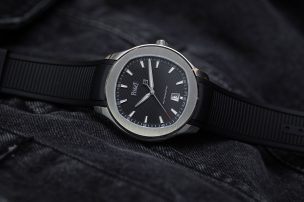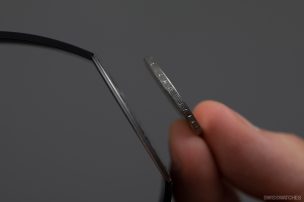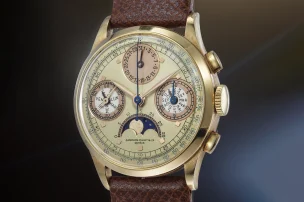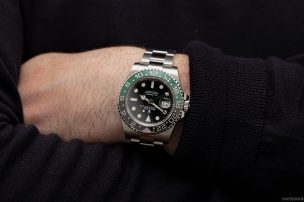

Jaeger-LeCoultre Polaris Perpetual Calendar: First Of Its Kind
The perpetual calendar: a historic mechanism that dates back as early as 1695, first appearing within a clock. But it was the renowned watchmaker Thomas Mudge who first put it onto the wristwatch map, creating a perpetual calendar movement for his No. 525 watch in 1762. Over a century later, the then-‘LeCoultre & Cie’ developed its first ever perpetual calendar pocket watch, eventually integrating the complication into a wristwatch for the first time in 1937.
Since then, Jaeger-LeCoultre has become renowned for its use of the complication. Romantics will be interested to learn that the reason this manufacture is particularly passionate about such ‘celestial’ complications and astronomical phenomena is because of its location in the Swiss Vallée de Joux, where the night sky is known to be exceptionally clear. Next up on its cosmological journey, the historic watchmaker is introducing a perpetual calendar watch into its Polaris collection.
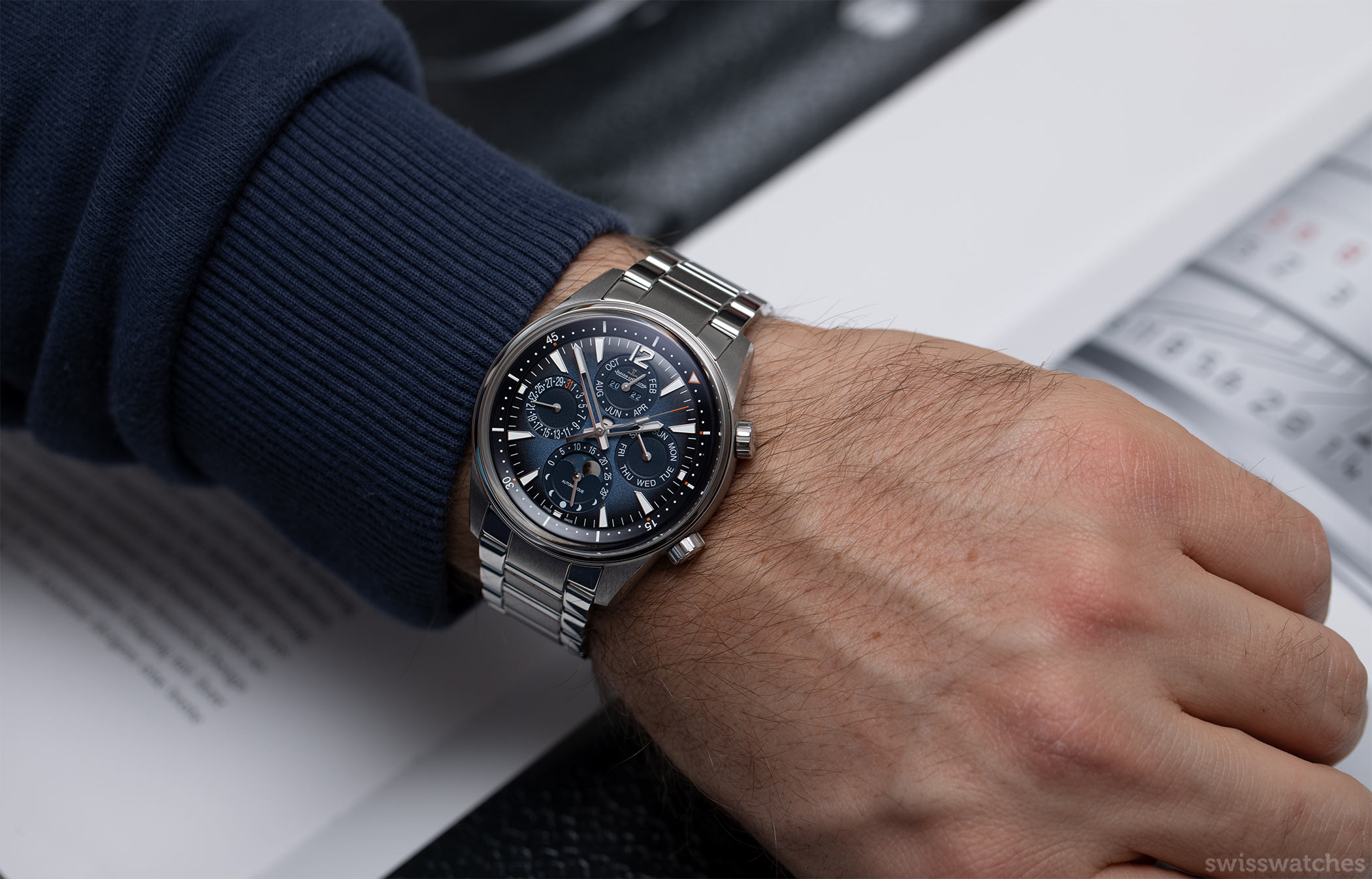
Roots of the Polaris collection
Technically, the Polaris has been around since 1968, being christened the Memovox Polaris. Yet the original model wasn’t like the Polaris we know today. Rather, it was a sort of step along from the Memovox models, known best for their alarm mechanism. The aim of this mechanism, integrated into a self-winding calibre, was to sound an alarm to audibly warn divers when it is time to return to the surface. The first ever Polaris watch’s sizeable case diameter of 42 mm made it an unusual piece for the time. Furthermore, unlike these days, the model had three – as opposed to two – crowns to control the watch’s functions. Its calibre was revered for its high performing functions, including the alarm, a date, hours, minutes, and seconds.
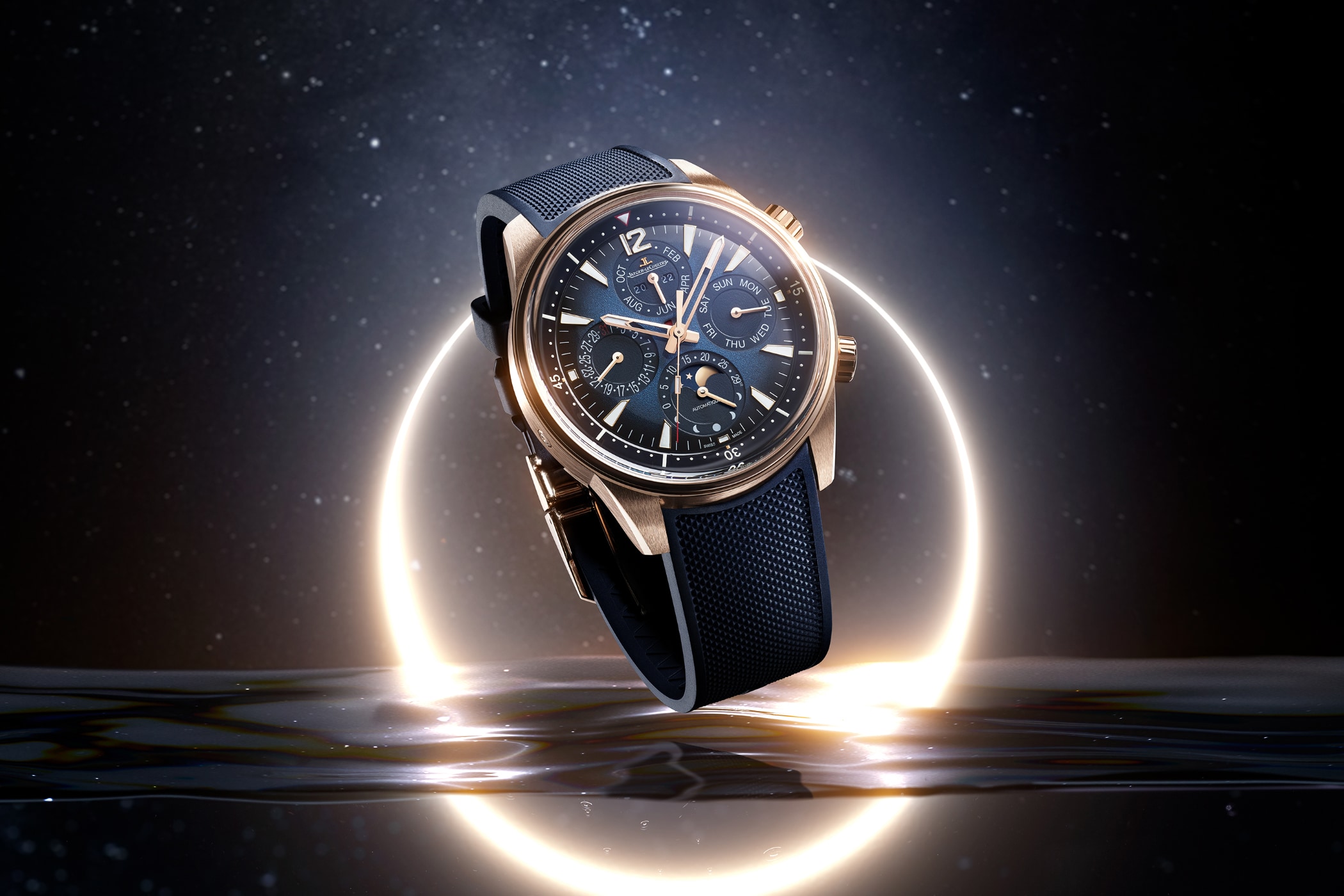
Since the relaunch of the Polaris in 2018 to mark 50 years since the first model (preceded only by occasional reissues), the modern-day Polaris Memovox remains (together with the Memovox from Jaeger-LeCoultre’s Master collection) the sole model to feature an alarm function. Other watches in the Polaris line include a Chronograph, Automatic, Date – and now the Perpetual Calendar. The aim of the collection is to provide a sporty yet elegant watch with a strong 70s vibe and a diving heritage, and it undoubtedly constitutes one of the company’s key collections.
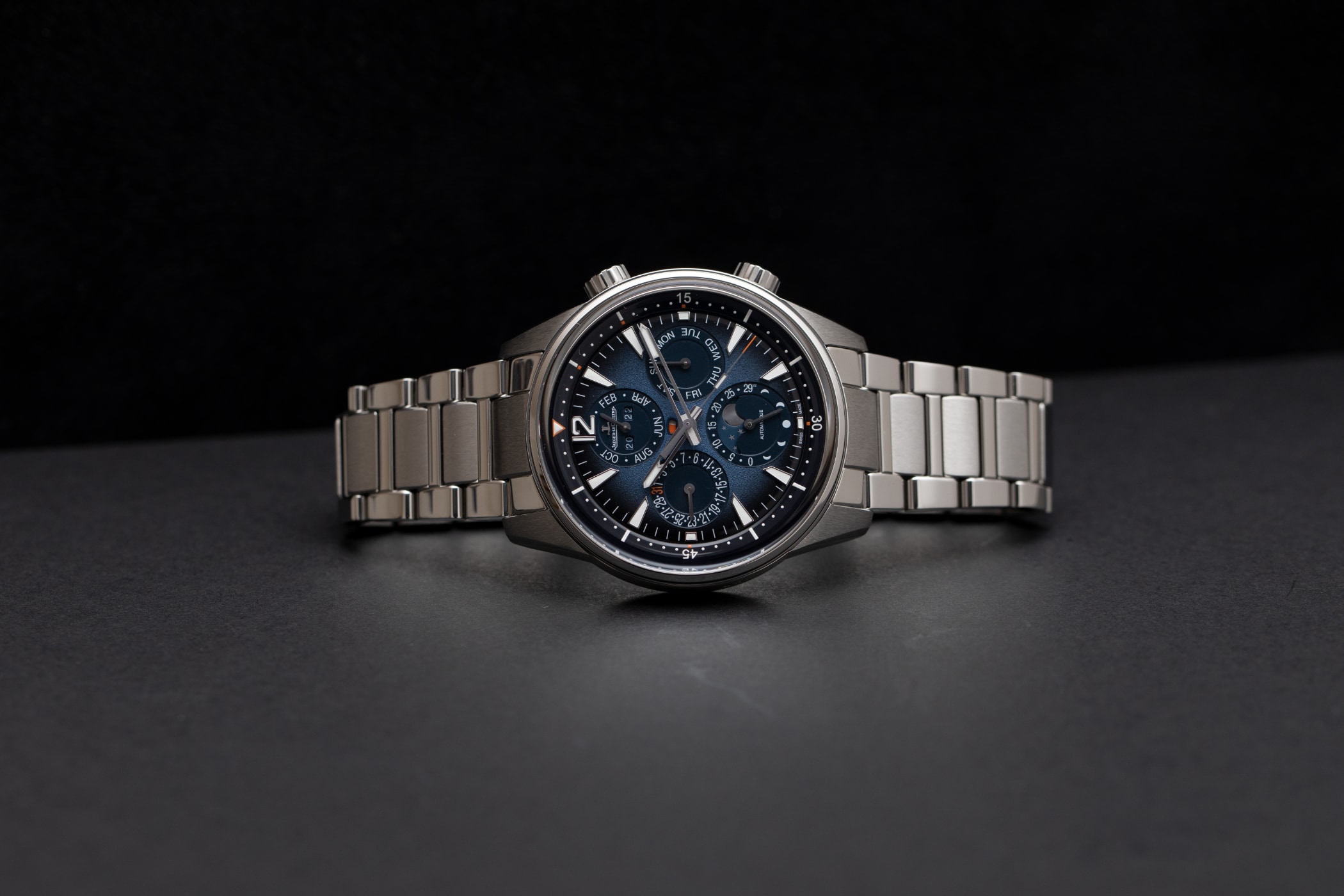
Now equipped with a little background and perspective, it’s time to take a closer look at the new Perpetual Calendar. Given that it is the first of its kind, it’s very interesting to see how Jaeger-LeCoultre is choosing to honour the DNA of this watch while introducing a novel, notably complicated model.
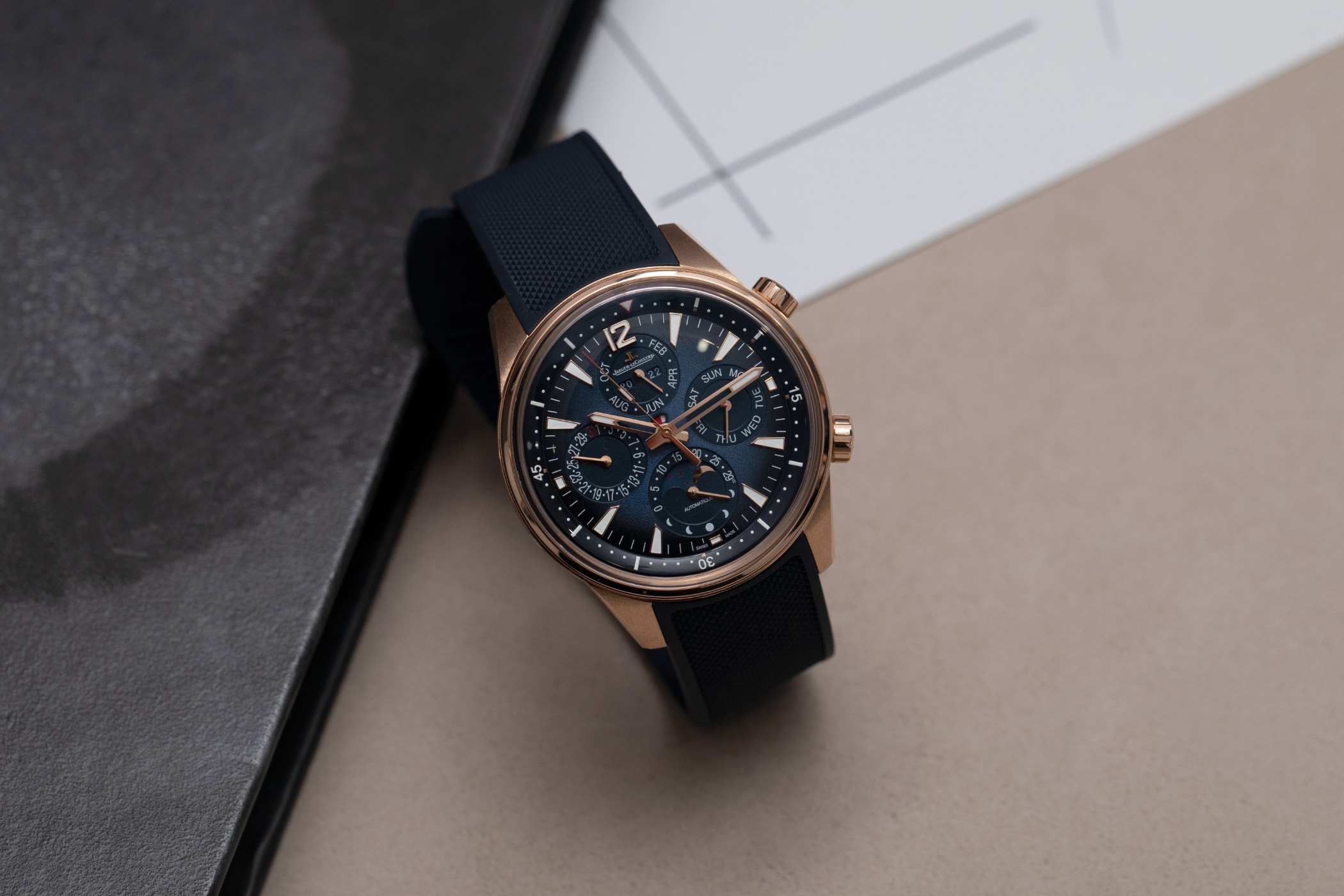
The dial
The dial of the Polaris Perpetual Calendar is a deep graduated blue, which gives a nod to the Polaris Mariner Memovox model from 2020. Additionally, according to Jaeger-LeCoultre, the graduated effect takes its inspiration from the ‘transition from day to night’. As a result, the dial gleams and catches the light; a simple but mesmerising feature for many a watch fan. The decision for a blue dial was also pretty fool-proof, given this is a colour that never seems to go out of style on men’s sports watches, especially those in steel. Coming in either a steel or rose-gold case, the dial uses sporty orange accents for the former material, and more classic red accents for the latter.
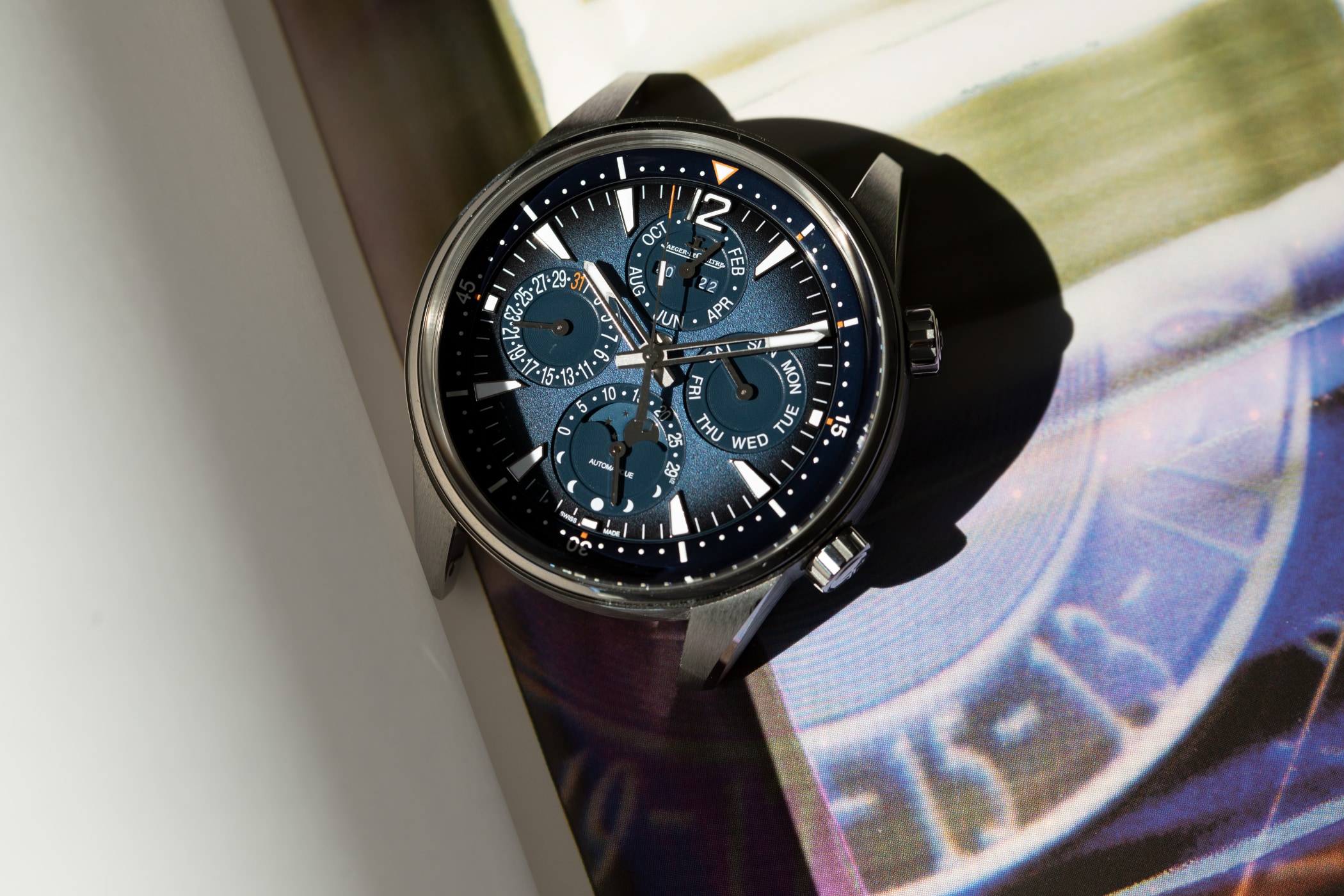
Moving onto the functions, the aim of the designers at Jaeger-LeCoultre was really to keep things uncomplicated and clean. The clarity they achieved is impressive. This is not least because unlike the watchmaker’s respected Master Ultra Thin Perpetual Calendar models, the Polaris needed to integrate both refined and bold elements to maintain the line’s DNA.
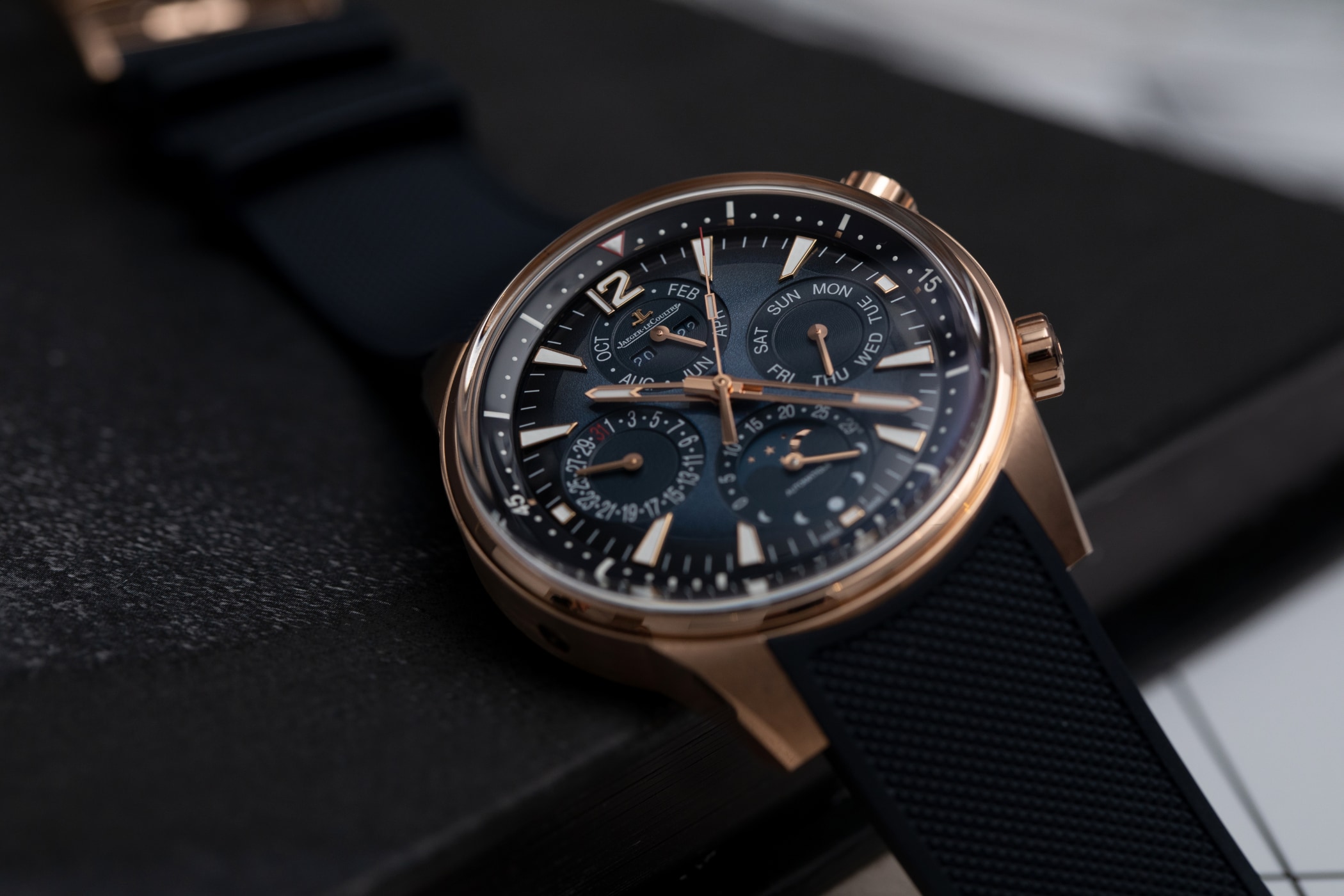
Consisting of four subdials in total, each one is slightly recessed and finished in a contrasting texture. This not only adds further depth to the dial, but also allows the wearer to differentiate between each one more easily. The dial displays the calendar indications using three subdials at 3 (day), 9 (date), and 12 (month and year) o’clock.
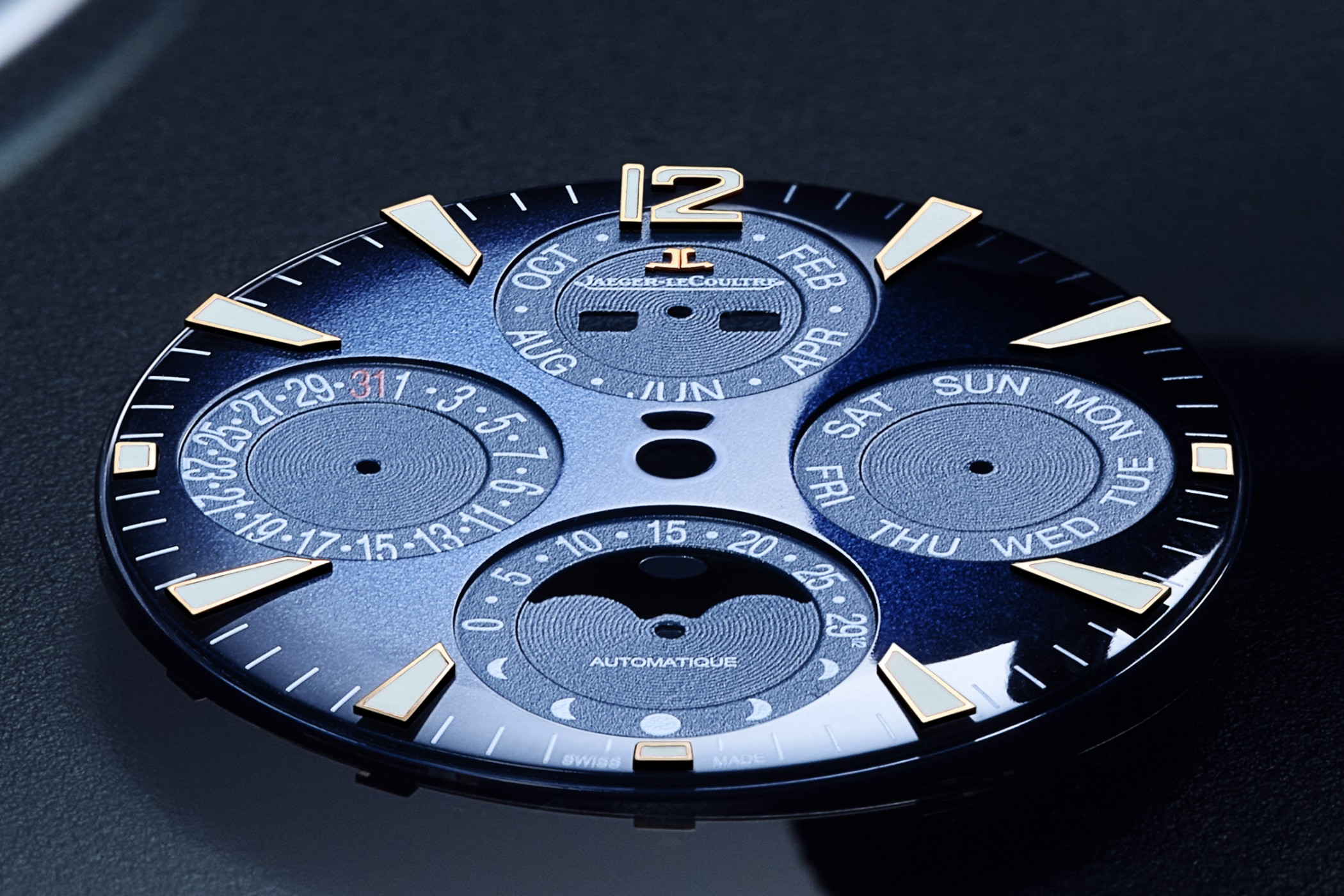
Meanwhile, the moonphase, which like the hands are brass, sits at 6 o’clock. What makes the Polaris Perpetual Calendar truly stand out is that it displays the moon phase in both hemispheres. The watch uses a retrograde display for the Southern Hemisphere, which frames a classical display for its Northern counterpart. Overall, the placement of these features is very pragmatic, and I find that pretty pleasing; a complicated watch that manages to keep things legible and in balance is worth commending.
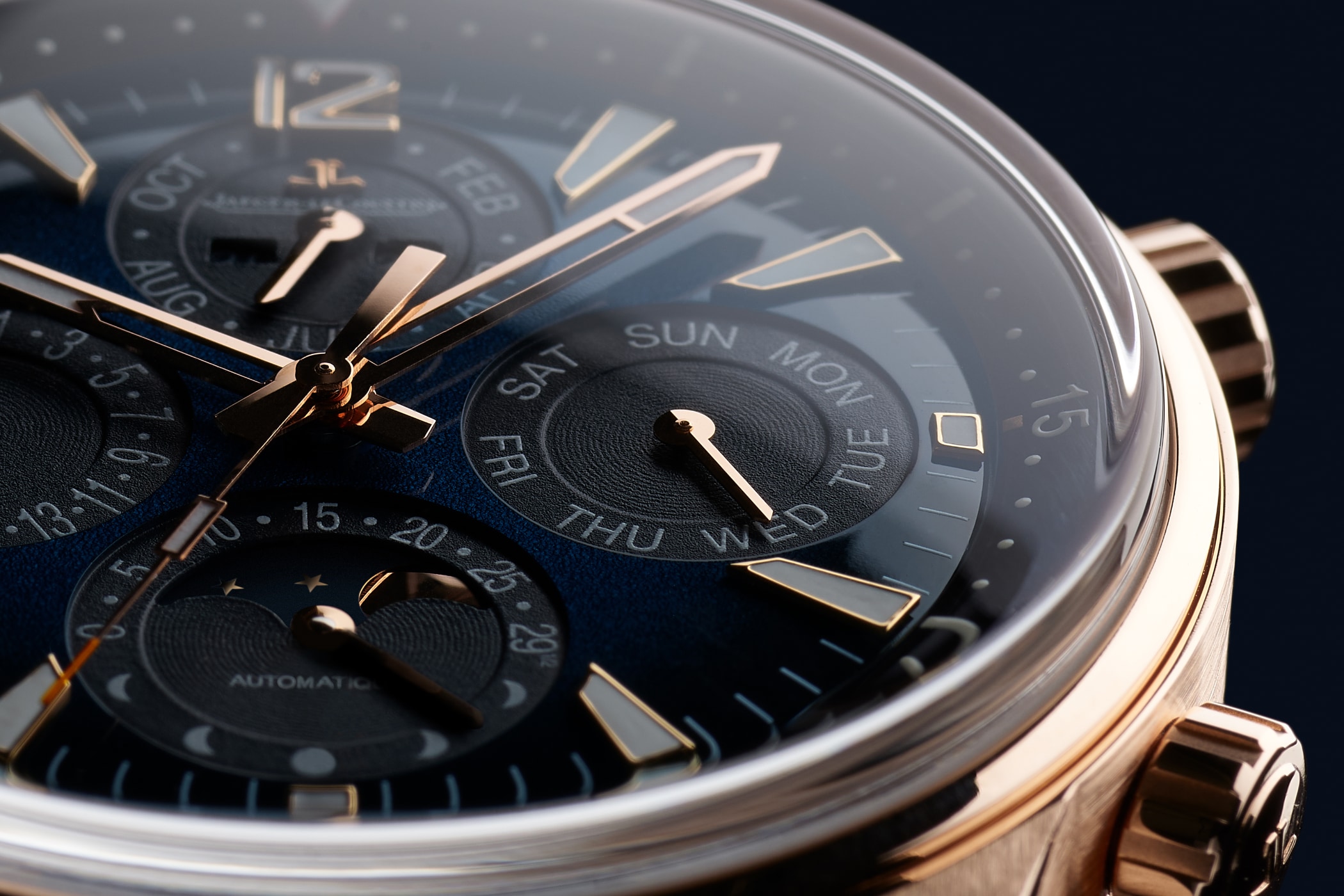
Having made our way around the dial, we can move along and take a look at the centre. Here lies yet another function: a ‘security zone indicator’. This little-known feature turns red between the hours of 20:00 and 4:00 in the morning, warning the wearer not to adjust the time or calendar settings. This small warning to leave the settings alone during this time protects components in the movement from potential damage.
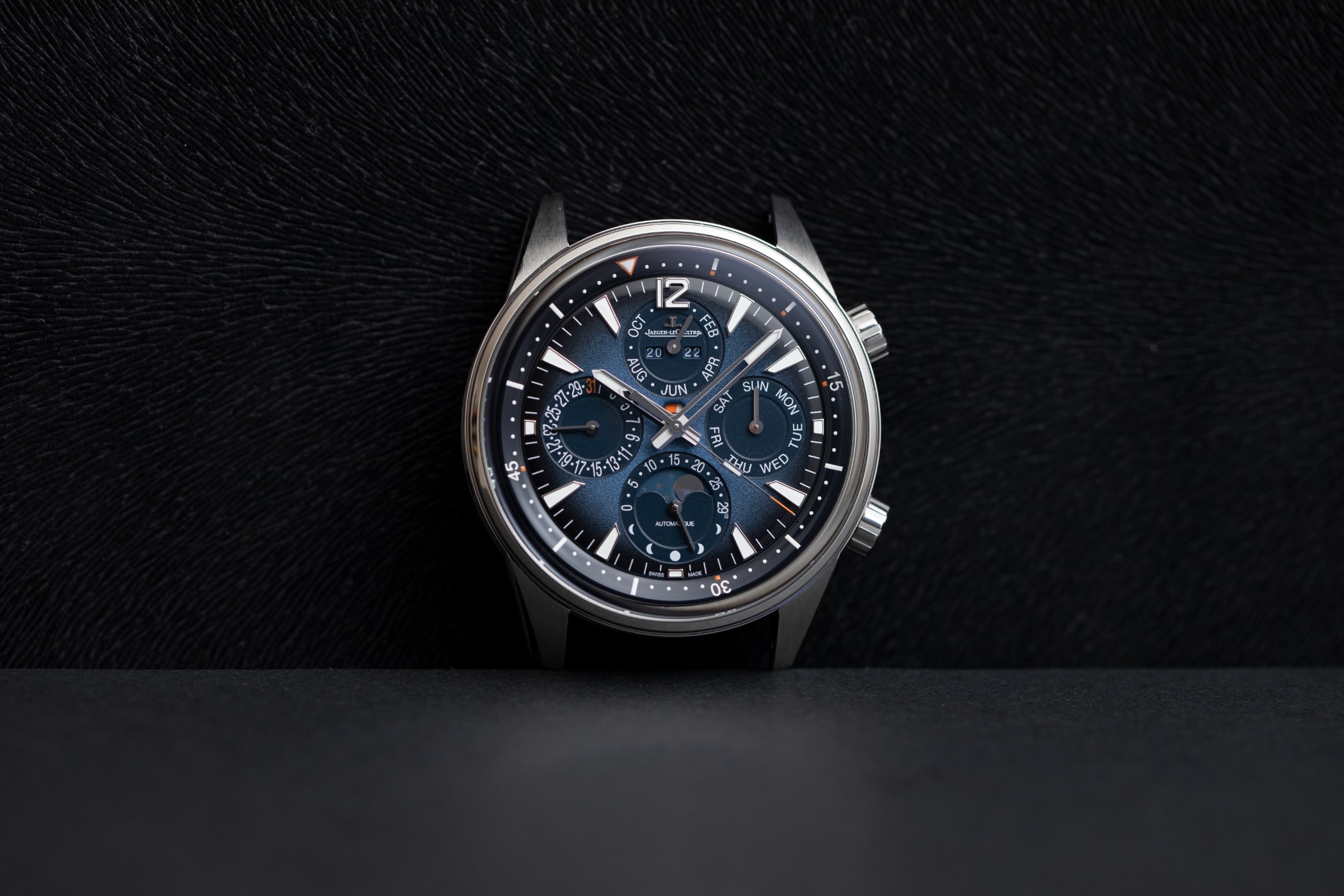
Given the number of subdials and functions on display, Jaeger-LeCoultre opt for partially skeletonised hands to keep things legible as humanly possible. Once again, the horology house keeps in line with the Polaris collection by using its typical trapezoid-shape indices. Their bold design is in complete contrast to the delicate, detailed complication functions displayed on the watch, making it easier for the wearer to seek out the function they’re looking for. Finally, these clear indices, alongside the hands’ luminescent coating that glows in a futuristic blue in the dark, are a reminder that the Polaris is an adventurous watch that is capable of providing support to the wearer beyond everyday use.
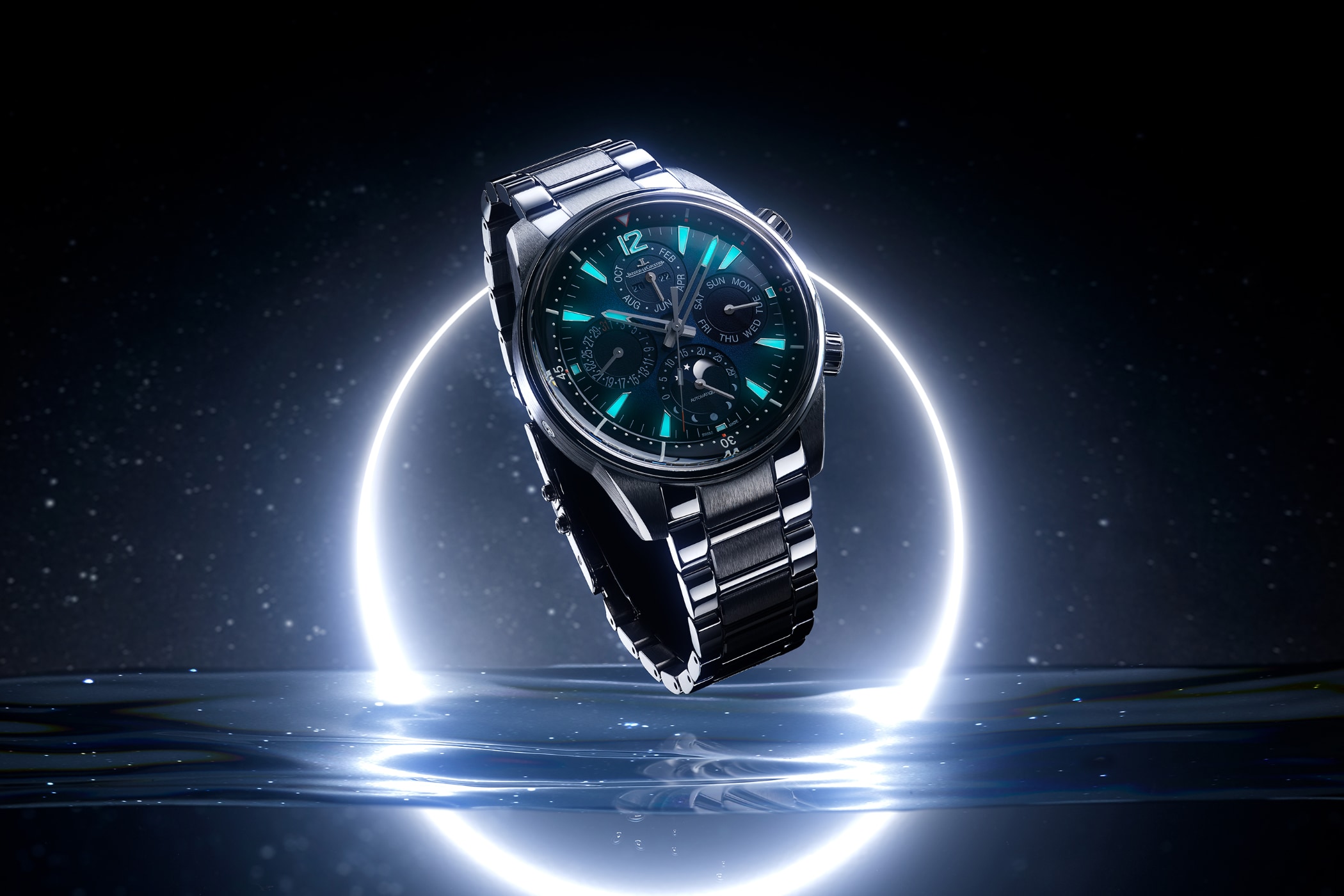
The case
The case materials of the two model watches cause them to head in totally different directions (sporty steel or elegant pink gold), making the watch impressively versatile. The two contrasting looks make for an intelligent business decision that is sure to create wider demand. While the rose-gold version is a glowing, quietly refined model that will fit in well at formal events, the steel edition is much more high adrenaline, quintessentially masculine, and perhaps fits a little more naturally to the Polaris DNA as a watch for adventure.
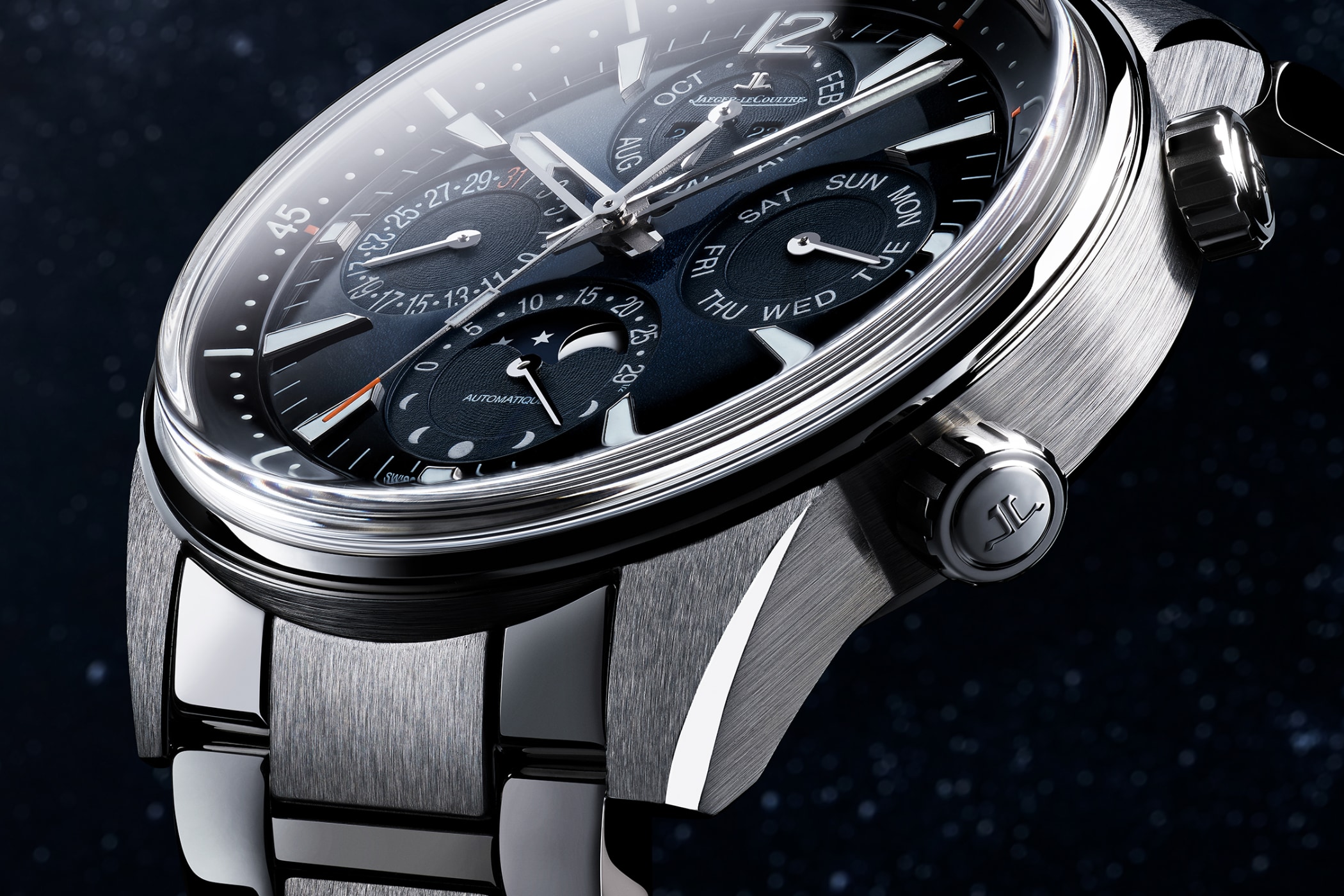
The case has all the hallmarks of a Polaris case design, from taut lines, a fine layered inner rotating bezel and glass-box sapphire crystal, to a finessed mix of brushed and polished surfaces. The case is water-resistant to 100 m. For such a sporty watch with a splash of diving heritage, it’s possible that some might hope for high resistance – even if only from a romantic rather than pragmatic perspective. For the vast majority, however, 100 m water-resistance will no doubt suffice.
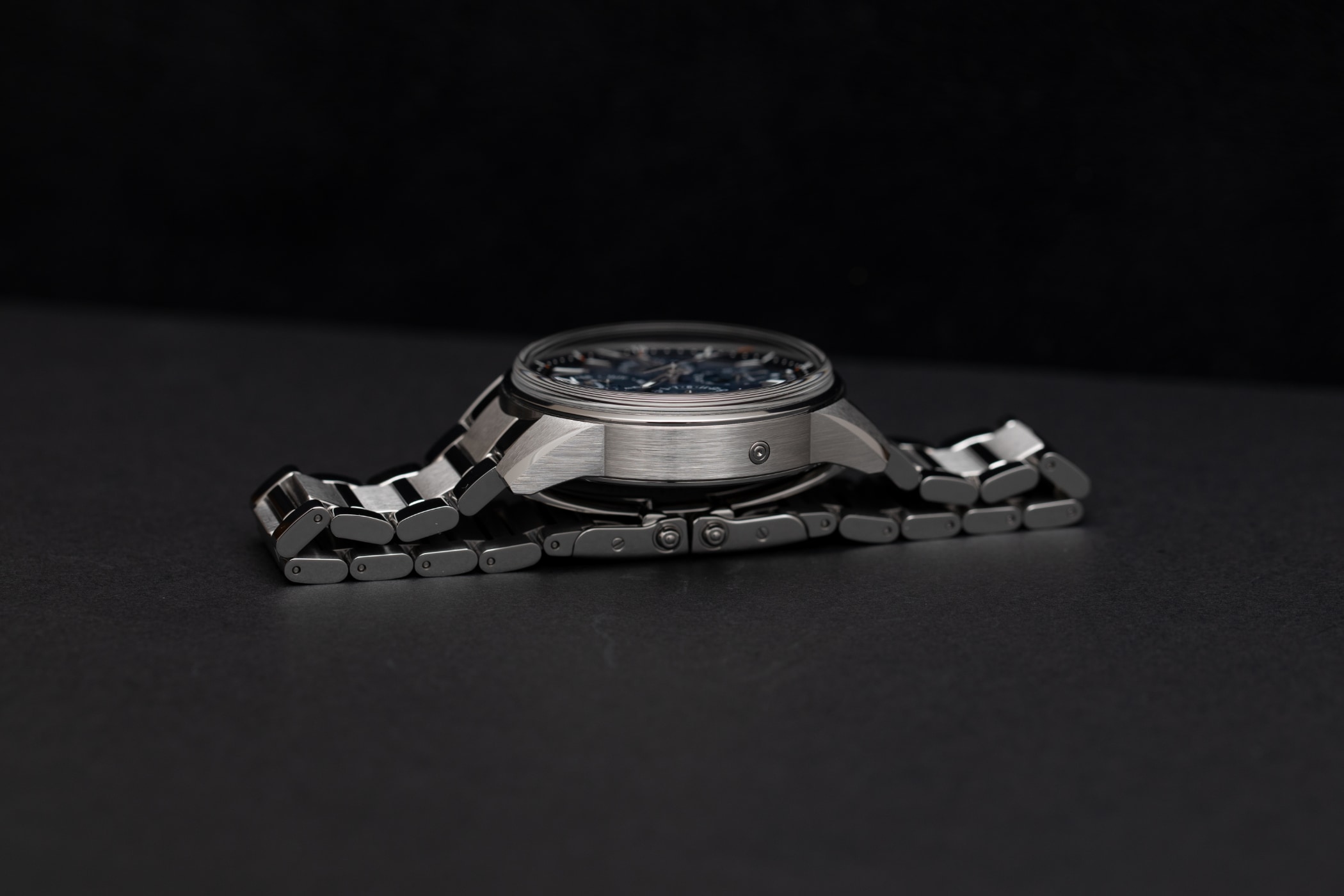
The crown
Despite a complex movement, the Jaeger-LeCoultre Polaris Perpetual Calendar is easy to operate and adjust (not that this is often necessary by any stretch). The top crown rotates the Polaris’ hallmark inner bezel, which is used for measuring elapsed time, while the lower crown sets the time and winds the watch. The wearer can adjust the calendar settings via a single pusher. From a wearability perspective, the crowns are relatively short in height. According to a male colleague (after all, this watch is definitely more for men), this results in the Polaris Perpetual Calendar sitting very comfortably on the wrist, without the crowns digging in as can sometimes be the case.
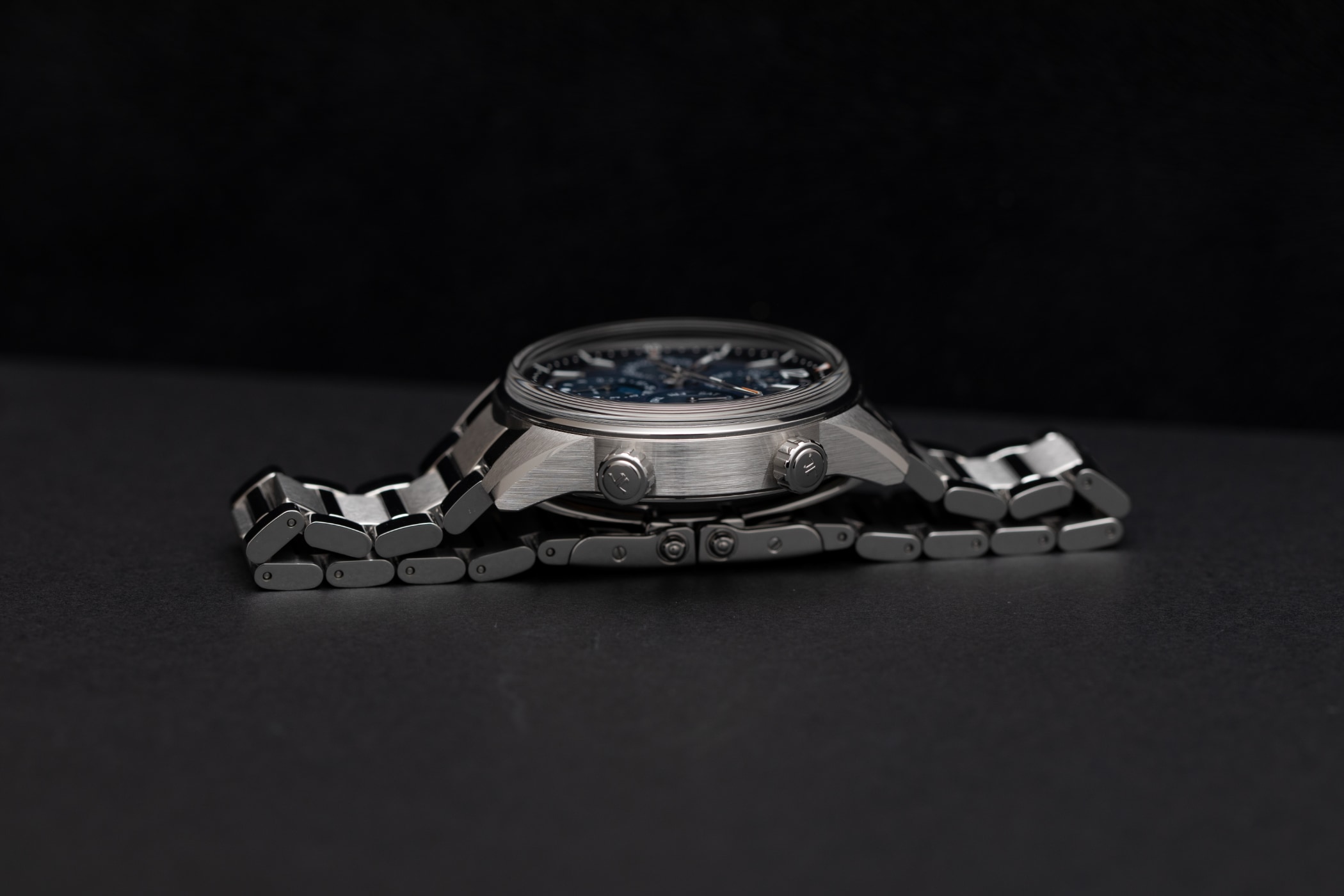
The bracelet
This brings us to the strap and bracelet options – again, a total game-changer that holds the unique power to reform the entire model. Fortunately, the watch is pretty easy to transform thanks to the company’s new interchangeable strap system. The wearer simply presses on the pushers between the lugs in order to swap out one option for another.
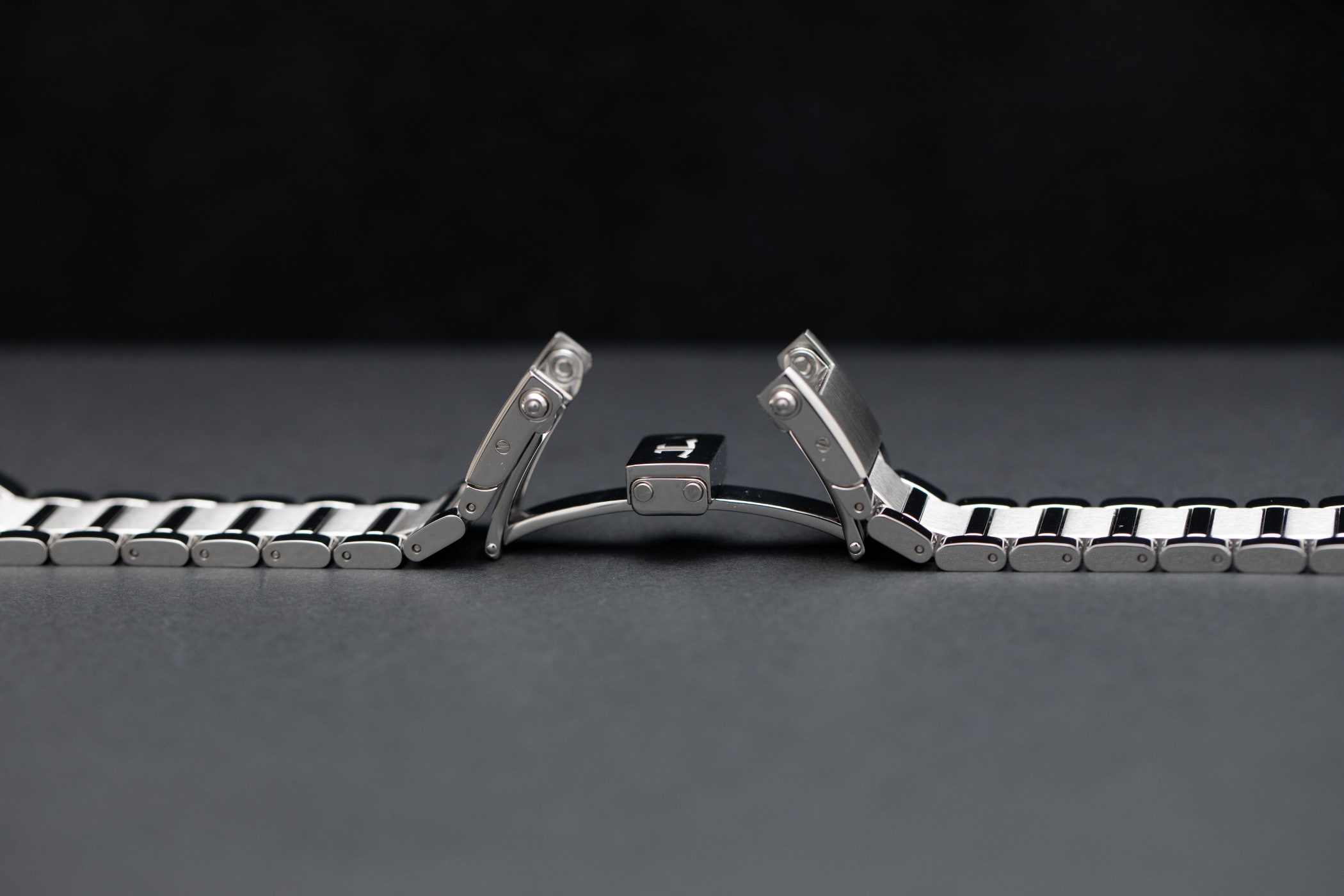
The steel and rose-gold versions both have different strap options. The steel version comes with a three-link steel bracelet or a textured rubber strap. It feels like rubber straps are only ever increasing in popularity, not least due to their incredible wearability as well as the cool and contemporary vibe they give off. Meanwhile, the rose-gold options exude athletic elegance by offering either a blue rubber strap that matches nicely to the dial, or an alligator strap with a folding buckle. The latter is particularly revolutionary, transforming the Polaris into a truly elegant timepiece. If none of these options speak to you, it’s also possible to choose from an array of calfskin straps.
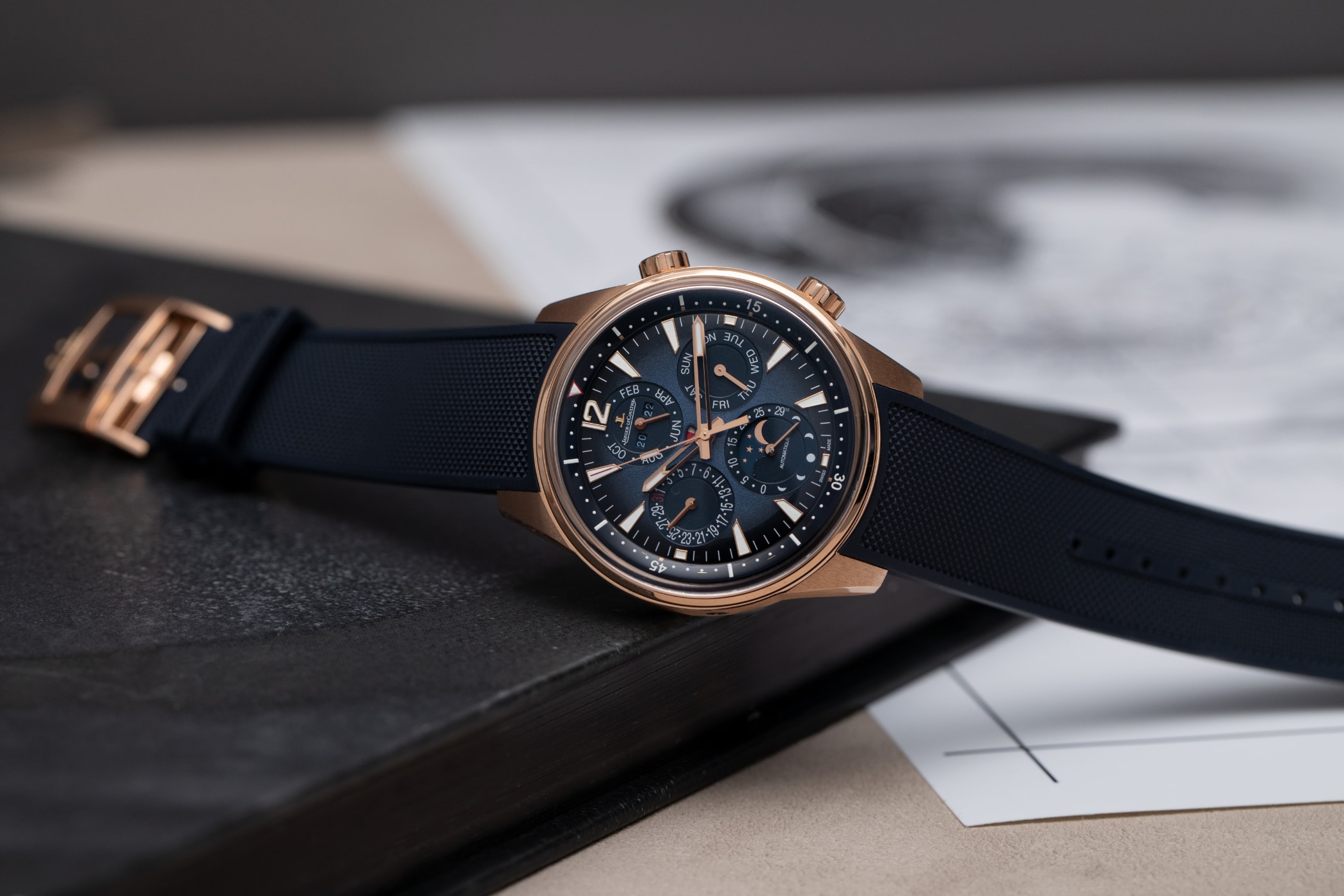
The movement
Powering the Jaeger-LeCoultre Polaris Perpetual Calendar is the new automatic in-house calibre 868AA, which has a 70-hour power reserve and beats at a frequency of 4 Hz. Its siblings have a slightly lesser power reserve of 65 hours. The 868AA is essentially the next evolutionary step for the watchmaker’s in-house perpetual calendar movement 868. That calibre made waves when it first appeared in 2013, in the Master Ultra Thin Perpetual Calendar, measuring only 4.72mm in height.
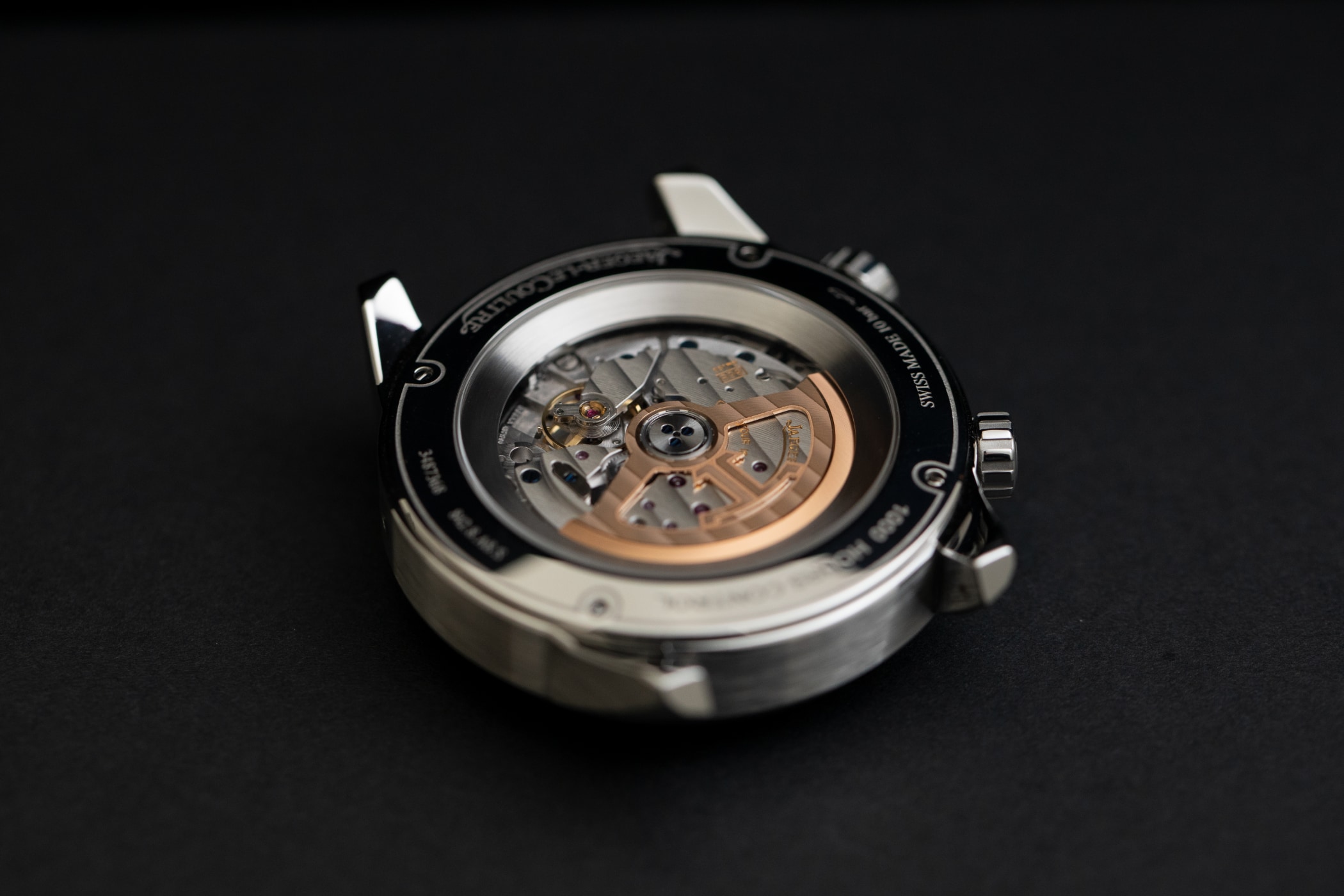
The most exciting part of this new movement is the perpetual calendar complication. Essentially, a perpetual calendar is a miniature mechanical computer that always shows the correct date, automatically adjusting for the different duration of months and even the leap years. It needs absolutely no manual correction until 2100, unlike a normal date display, which requires adjustment at the end of every month that doesn’t have 31 days.
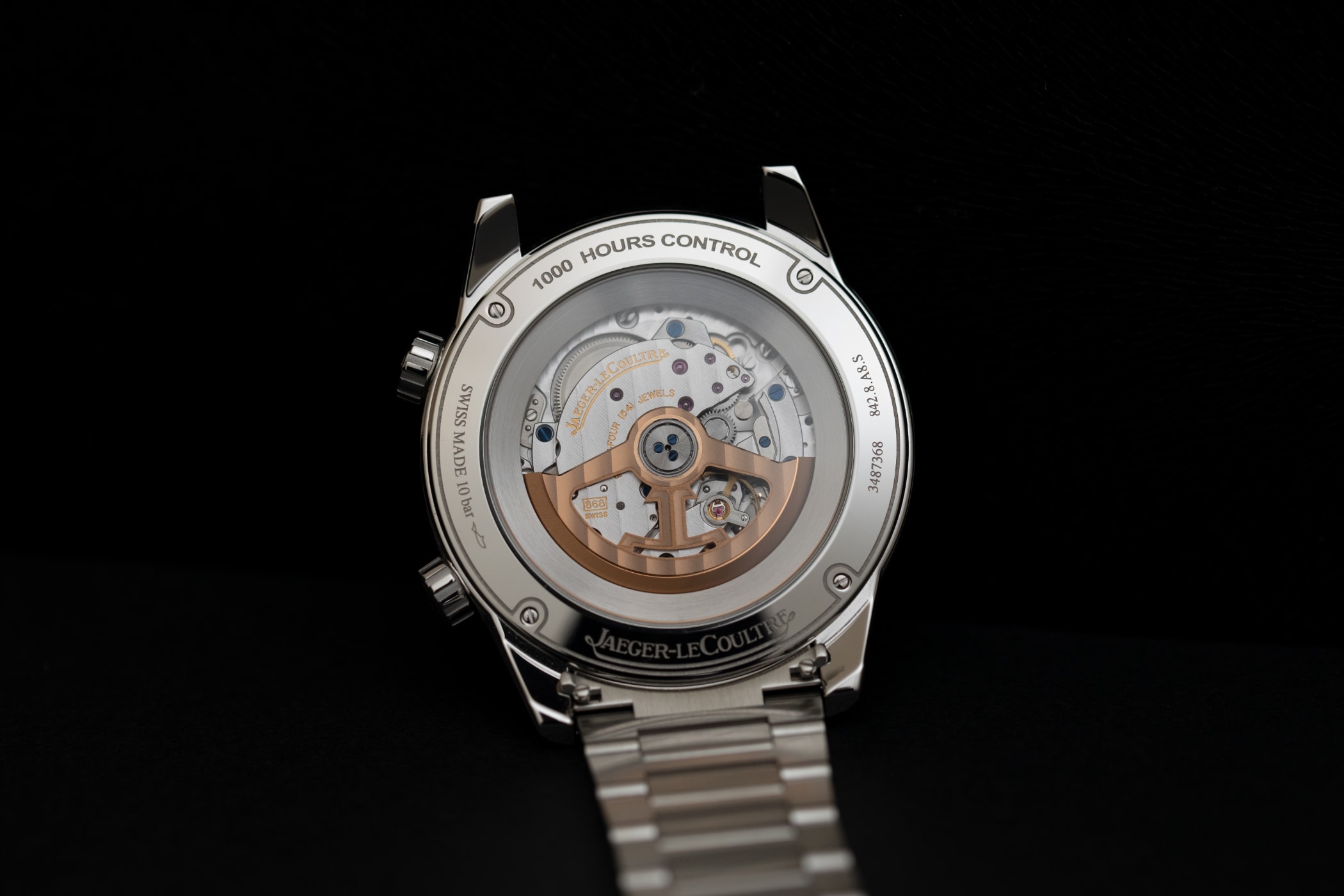
What makes this new calibre stand out is not only the extended power reserve, but also the fact that it displays moon phases in both hemispheres. Additionally, an open-worked pink gold winding rotor means the wearer can admire fine decorative finishes on the calibre, visible via the sapphire crystal caseback.
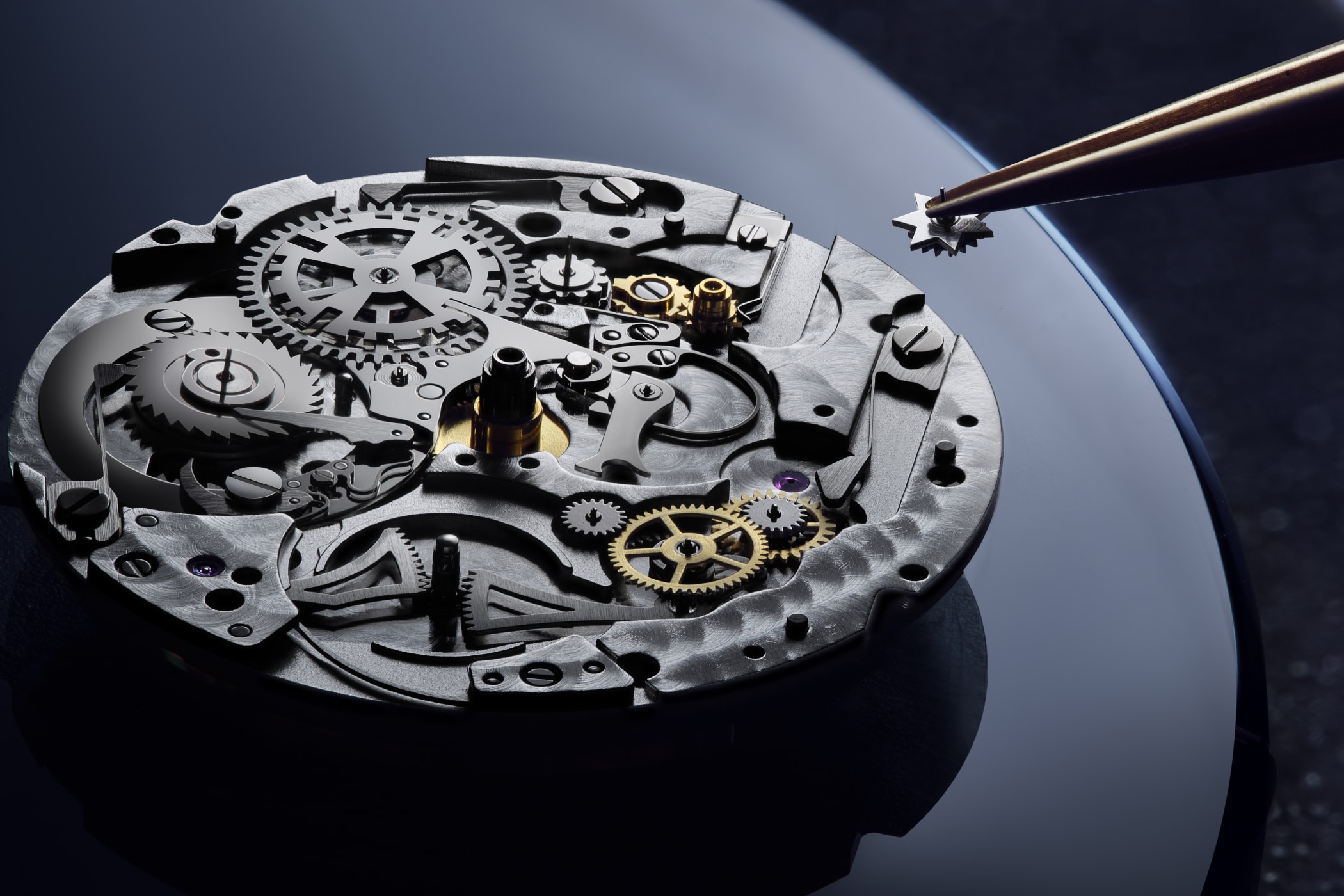
The Verdict
In my opinion, there is no complication more beautiful or more elegant than the perpetual calendar. Yet combining the elegance of this complication with the functionality required for a sporty watch is no easy feat. The Jaeger-LeCoultre Polaris Perpetual Calendar, however, seem to have it very well under control, as it seems that legibility was the main focus on this new Polaris. Jaeger-LeCoultre’s designers’ thoughtful positioning, balancing and sizing of every single subdial and feature is impressive.
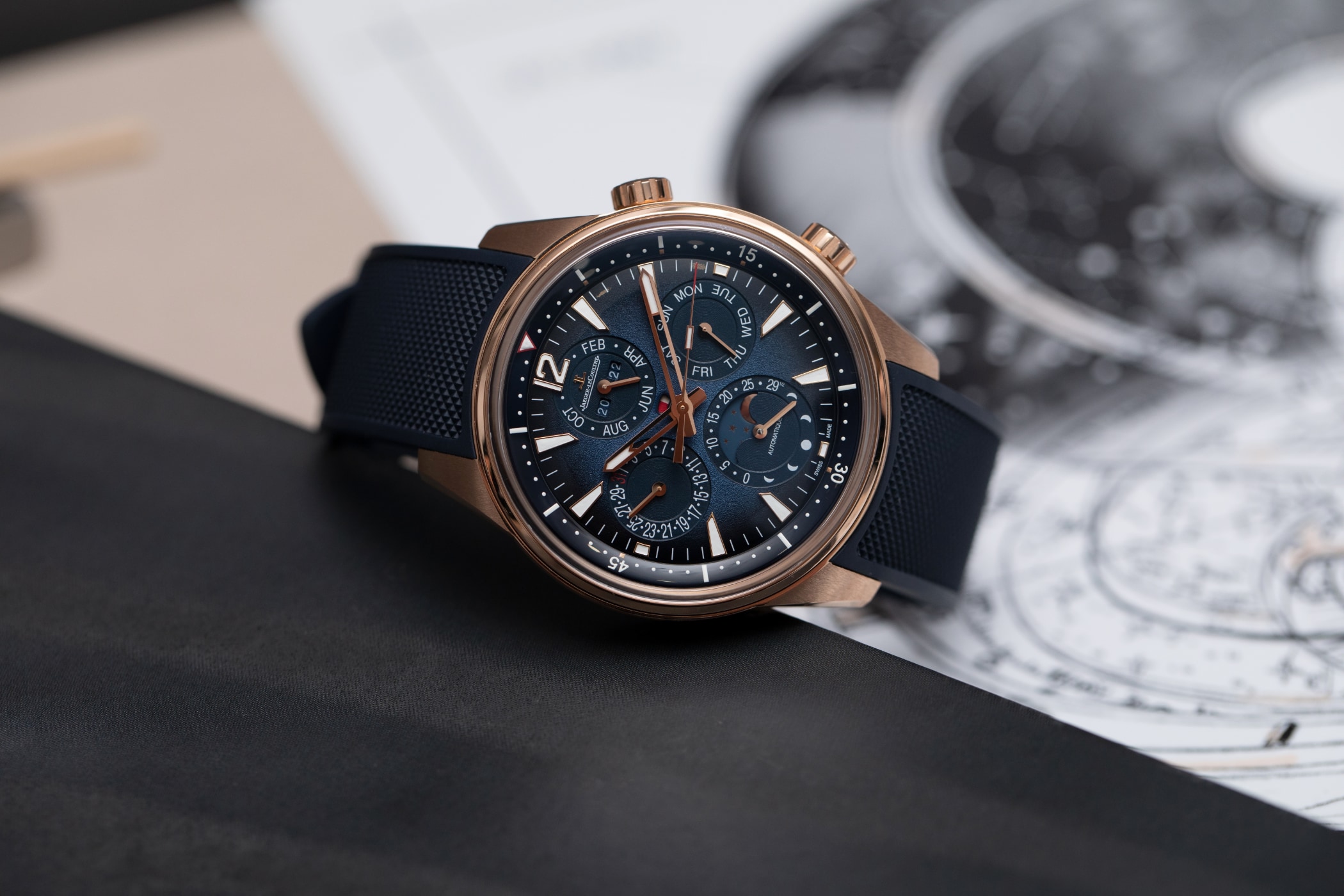
Secondly, what is notable about the two versions of this model is how very different they are. To me, this is genius. Jaeger-LeCoultre is introducing what will surely be a very popular model within a foundational line in two very different variations. While the rose-gold version will entice those looking for elegance and a formal option wrapped up into a luxury sports watch, the steel version is totally different, bringing a fast-paced masterpiece to the table. It’s hard to think of another watch that ends up having two such contrasting end effects.

The price is also definitely worth a mention. While the steel version (Q9088180) comes at a price of 30,500 euros, the pink-gold edition (Q9082680) costs 45,600 euros. To put this in context, the Master Ultra Thin Perpetual Calendar in steel costs 24,000 euros (so 6,500 euros less), while a rose-gold version is priced at 37,100 euros (8,500 euros less). Of course, these are two totally different collections, but it does give us some idea of price placing. The new Polaris Perpetual Calendar brings something new to the table, primarily standing out for its novel calibre. The inception of a brand new calibre – not least one displaying the moon phases in both hemispheres – is neither simple nor inexpensive to create, meaning I for one am actually grateful that the price is not higher.

If we were to calculate the Jaeger-LeCoultre Polaris Perpetual Calendar, it would look something like this: broad appeal of two very different aesthetics + a complicated new movement + a reputable luxury Swiss horology house + a pretty attractive price point = we have ourselves a surefire bestseller.
Ref. Q9082680 (pink gold)
Height: 11.97 mm
Ref. Q9082680 (pink gold) interchangeable rubber strap and alligator leather strap
red security zone, inner rotating bezel
EUR 45,600 (pink gold)


